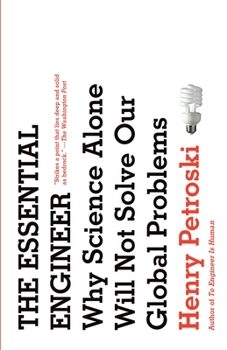The Essential Engineer: Why Science Alone Will Not Solve Our Global Problems
Select Format
Select Condition 
Book Overview
From the acclaimed author of The Pencil and To Engineer Is Human , The Essential Engineer is an eye-opening exploration of the ways in which science and engineering must work together to address our world's most pressing issues, from dealing with climate change and the prevention of natural disasters to the development of efficient automobiles and the search for renewable energy sources. While the scientist may identify problems, it falls to the engineer to solve them. It is the inherent practicality of engineering, which takes into account structural, economic, environmental, and other factors that science often does not consider, that makes engineering vital to answering our most urgent concerns. Henry Petroski takes us inside the research, development, and debates surrounding the most critical challenges of our time, exploring the feasibility of biofuels, the progress of battery-operated cars, and the question of nuclear power. He gives us an in-depth investigation of the various options for renewable energy--among them solar, wind, tidal, and ethanol--explaining the benefits and risks of each. Will windmills soon populate our landscape the way they did in previous centuries? Will synthetic trees, said to be more efficient at absorbing harmful carbon dioxide than real trees, soon dot our prairies? Will we construct a "sunshade" in outer space to protect ourselves from dangerous rays? In many cases, the technology already exists. What's needed is not so much invention as engineering. Just as the great achievements of centuries past--the steamship, the airplane, the moon landing--once seemed beyond reach, the solutions to the twenty-first century's problems await only a similar coordination of science and engineering. Eloquently reasoned and written, The Essential Engineer identifies and illuminates these problems--and, above all, sets out a course for putting ideas into action.
Format:Paperback
Language:English
ISBN:0307473503
ISBN13:9780307473509
Release Date:March 2011
Publisher:Vintage
Length:288 Pages
Weight:0.74 lbs.
Dimensions:0.8" x 5.3" x 8.0"
Customer Reviews
3 ratings
Science and Engineering
Published by Thriftbooks.com User , 15 years ago
Petroski aims to clarify the difference between science and engineering. He says that "engineering and medicine are more like each other than like science." The book's subtitle, //Why Science Alone Will not Solve Our Global Problems,// focuses Petroski's conviction, drawing upon the support of some of the most creative scientific minds of the 20th Century, including Albert Einstein. One of the main problems with technological rescue, Petroski claims, is its high cost. The Europeans, he says, are way ahead of the U.S. in the race for renewable energy. The reason for their success is the high cost of petroleum-based fuel. When the cost of petroleum energy exceeds renewable energy, technology will expand in that direction. Petroski explains in clear English how our engineering will find a new way to harness the vast technology already within our grasp. His ideas bridge the once-clear gulf between science and engineering. Engineering has shifted away from mere scientific application. The new technology, he claims, emerges from the amalgamation of different areas. If need is the mother of invention, then technology is the godfather of engineering. The author sees the day when technology will fill niches and support our ingenuity to fabricate a more efficient world. Reviewed by D. Wayne Dworsky
An eloquent case for engineering
Published by Thriftbooks.com User , 15 years ago
In this highly engrossing book, Petroski eloquently challenges a fundamental and profound bias in our society--the relegation of engineers and engineering to second-class status among professions. He traces to roots of the perceived primacy of science over engineering to the Western Platonic bias that "ideas are superior and prerequisite to things" and to the simplistic linear model of research-before-development promulgated by science administrator Vannevar Bush in the 1940s. Petroski uses examples such as the steam engine, powered flight and rocketry, to demonstrate that engineering often leads science, and also that science is a tool of engineering. He also compellingly describes the optimistic, challenging, rewarding nature of engineering, showing its satisfying creativity. And to demonstrate the richness of engineering, he takes the reader through a tour of technologies as seen through the eyes of an engineer, including speed bumps and humps, dams, climate change, "geoengineering" of the earth to combat climate change, renewable energy, nanotechnology, robotics, structural earthquake engineering, hurricane protection, airline accidents, the electric power grid, evolution of the automobile, and "financial engineering." This book is essential reading, not only for engineers and students, but for all of us who benefit from the vast wealth of technology that makes modern life possible.
About the similarities and differences between science and engineering
Published by Thriftbooks.com User , 15 years ago
"The Essential Engineer" is on the ROROTOKO list of cutting-edge intellectual nonfiction. Professor Petroski's book interview ran here as the cover feature on March 26, 2010.





